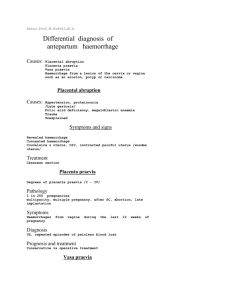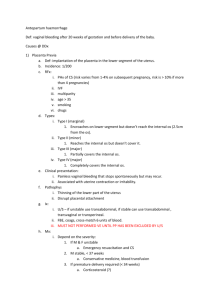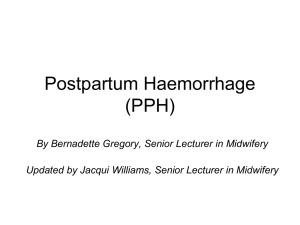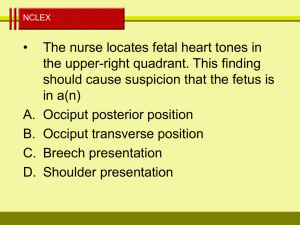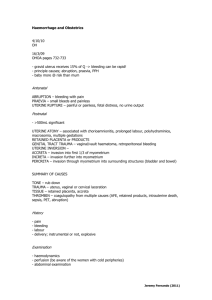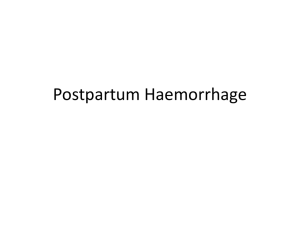antepartum hemorrhage
advertisement
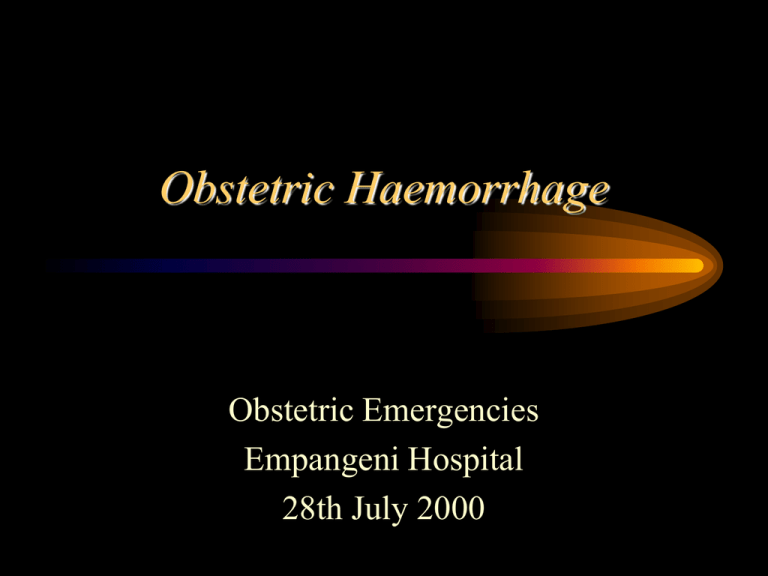
Obstetric Haemorrhage Obstetric Emergencies Empangeni Hospital 28th July 2000 Obstetric Haemorrhage Causes of ANTEPARTUM haemorrhage • Abruptio Placentae • Placenta praevia • Local causes • Unknown origin ABRUPTIO PLACENTAE Underlying pathology • Hypertensive Disease • Multiple pregnancy • Trauma • Anaemia • Polyhydramnios PLACENTA PRAEVIA Predisposing factors • Previous Caesarean Section • Most have no known cause – presumed late implantation Local & Unknown Causes of APH • • • • • Rupture of uterus Carcinoma of cervix Trauma Cervical polyp Bilharzia of cervix • ? Edge bleed • ? Haemorrhoids Obstetric Haemorrhage • Induction of labour with oxytocin is associated with an increased rate of uterine rupture in gravid women with 1 prior uterine scar, in comparison with the rate in spontaneously labouring women. Abruptio Placentae Features • Pain and tenderness • Often I.U.F.D • “Hypotension on hypertension” • Clotting defects • Renal impairment Antepartum Haemorrhage • Exclude abruption, uterine rupture, placenta praevia with labour • Is she stable? - ?BP, pulse • Check Abdomen - previous C/S scar, fundal height and uterine tenderness • Check FH • Vaginal examination and ARM Abruptio placentae Abruptio Placentae • Resuscitate - FDP, whole blood • Monitor BP and urine output • Give oxytocin infusion or prostaglandin if necessary to induce contractions • Avoid Caesarean Section unless salvageable baby, or no progress • Watch out for PPH Placenta Praevia • Diagnose by Ultrasound • Resuscitate, monitor BP and amount of bleeding • Persistent bleeding requires delivery whatever the gestation • 34 weeks - buy time for steroids • prevent contractions with indocid Placenta Praevia • Transfer anterior placenta praevia • Elective caesarean if 37 weeks • Never cut through the placenta • Lower segment may need to be packed Post Partum Haemorrhage Predisposing factors • Antepartum haemorrhage • Multiple pregnancy • Prolonged labour • Caesarean Section Post Partum Haemorrhage Causes * Uterine atony * Obstetric trauma Post Partum Haemorrhage Atonic uterus (soft uterus) * Compression - bimanual is best * Oxytocin - 10 units IV * Syntometrine 1 amp IM * PgF2α 5mg in 500 ml IV * Misoprostol (PgE1) 1mg (5 tabs) rectally Trauma (hard uterus) * Vaginal tears are most common * Cervical tears rare unless instrumental * Remember the ruptured uterus * Uterine inversion Post Partum Haemorrhage Other causes • Instrumental Delivery • After Caesarean Section • Infection - 2° PPH • Retained placental fragments Post Partum Haemorrhage • • • • • • Rub up a contraction Get help Insert two large bore IV lines - Haes-Steril Give an oxytocic Explore digitally for fragments and tears Explore with speculum for tears - especially cervix • Evacuate under GA Rupture of Uterus Two types • True rupture • Dehiscence of scar Rupture of Uterus True Rupture • Contractions stop • Continuous pain • Tender abdomen • Fundus ill-defined • PV Bleeding • Fetal heart dips or absent fetal heart Scar Dehiscence • Dehiscence may be silent – no bleeding • Fetal distress • Haematuria • Vague uterine outline • Failed induction Rupture of Uterus • High Index of suspicion in grande multips and in scarred uteri • All cases of Ante and Intra partum haemorrhage must exclude rupture • Laparotomy if suspected • Repair or Hysterectomy? Surgical Management • • • • • Direct suture Stepwise devascularisation Internal iliac artery ligation Hysterectomy B-Lynch, “foley tourniquet”, packing Stepwise Devascularisation
